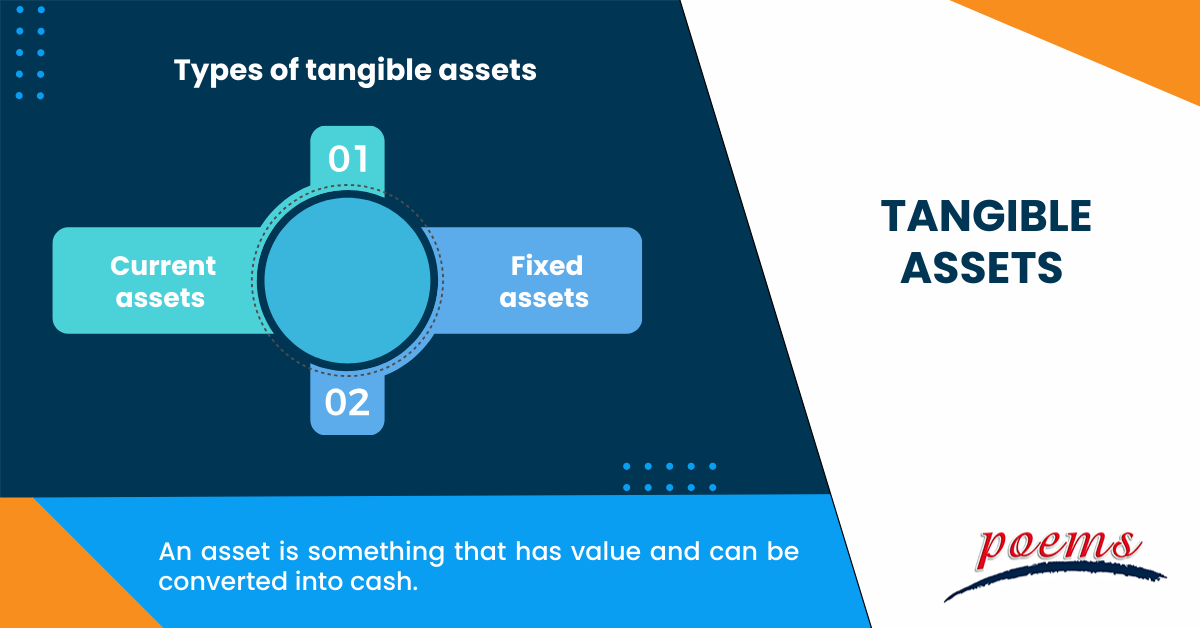Tangible assets
Table of Contents
Tangible assets
An efficient asset management system is crucial for maintaining assets since they give a complete picture of a company’s net worth. Since they are employed daily for production and asset consideration, a tangible asset helps the company daily. The physical resources a company needs to produce goods and services are tangible assets. The value diversification of tangible assets will likely shield investors from future uncertainties or economic downturns.
What is a tangible asset?
An asset is something that has value and can be converted into cash. Tangible assets are physical objects that can be seen and touched, such as land, buildings, vehicles, machinery, and inventory.
A tangible asset often has a physical form and fixed monetary worth. Your business’s core is made up of tangible assets. They are typically not for sale to customers, yet they constitute a significant portion of the value of your business. Although tangible assets have the advantage of being used in the real world, they also require extra care for physical protection and preservation.
Understanding tangible assets
A tangible asset is a physical item with a specific value. As a result, these resources are crucial to the effectiveness of corporate organisations. The availability of these resources makes it easier to produce and manufacture goods. They are, therefore, essential to ensuring a businesses’ profitability. These resources contribute to businesses’ growth and cash flow by creating and delivering goods and services.
Companies can convert these assets into cash to assist them in times of need or financial difficulty. These material possessions may be pledged as collateral for loans from lenders. Physical assets gradually lose value due to depreciation over time. Due to this, businesses using those assets are qualified to get tax benefits without having to mark any cash outflows from their operations.
Types of tangible assets

The types of tangible assets are:
- Current assets
A business uses its current assets when it is in a critical or immediate financial necessity. Inventory, cash, or occasionally tradable bonds or securities make up these funds, typically spent within a year. They are listed in the company’s balance sheet since they are shown to be significant financial assets and are necessary for daily operations.
- Fixed assets
Fixed assets include machines, equipment, and vehicles the company owns and uses to operate and support daily production. They are necessary for the business to run continually. These objects fall under the area of machinery, tools, and equipment. Revenue is the term used to describe the money made possible by these physical assets.
Pros and cons of tangible assets
The following are the various pros of tangible assets:
- Adding tangible assets to your portfolio is a great way to diversify and increase value. Additionally, the bond or stock market movement has little impact on these investments. They may even protect against market dangers that intangible assets cannot.
- People who support tangible assets emphasise their ability to act as an inflation hedge. Moreover, tangible investments like gold bullion or bars have historically masked inflation.
- The enjoyment of investing in tangible things is a non-financial reward. Fine art and rare object collectors enjoy not only assembling their collections but also the potential future returns on their investments. Although your home gives your family comfort and enjoyment, it may have long-term value.
The following are the various cons of tangible assets:
- The non-exclusive nature of tangible assets is one of its drawbacks. Making oneself stand out is the best strategy to produce income. Tangible assets, however, are not distinguishable. Other investors or businesses may hold the same tangible assets in your portfolio.
- Investments in tangible assets are not for you if you don’t like to maintain your property actively. Managing tangible assets like real estate and land takes much time and effort. In addition, it is expensive. Rates, maintenance and insurance are paid to maintain your real estate investments. Also, you must pay for storage when you buy precious metals.
Examples of tangible assets
To understand how the concept works, consider the following tangible asset example. A high-cap firm owns many fixed assets, such as machinery, equipment, and plants. Companies engaged in the oil and gas or the real estate sector frequently have many tangible assets.
As a result, they manufacture more to increase sales, satisfy consumer demand, and boost profits. Service-based businesses, like software production units, have real assets that aid in the proper execution of their original ideas. These businesses prioritise intellectual property, nevertheless. They have patents and copyrights for the things they create and the concepts they have. Microsoft, Infosys, and other such service providers are a few examples.
Frequently Asked Questions
Physical items that can be seen, touched, or felt are tangible assets. Non-financial items that cannot be seen or handled are intangible assets. Tangible assets include land, cars, and buildings. Intangible assets include contracts, financial claims, and patents.
The main benefit of tangible assets is that the value of a company’s tangible assets is always sold to generate cash. Companies in higher-risk sectors, including banking and finance, reassure investors by utilising their tangible assets. The business will be secure if its tangible assets are worth more than the money it risks.
An asset that has physical substance makes it tangible.
The total physical assets of a corporation, less all intangible assets and liabilities, are referred to as net tangible assets. Net tangible assets enable analysts to concentrate solely on a company’s physical assets. To determine a company’s net tangible assets, take its total assets and deduct its liabilities, the par value of its preferred shares, as well as any intangible assets like goodwill, patents, and trademarks.
A company’s net tangible assets are important because they give a glimpse into the level of risk it is exposed to, as well as its liquidity and solvency. They are also utilised to
Related Terms
- Margin Requirement
- Pledged Asset
- Stochastic Oscillator
- Prepayment risk
- Homemade leverage
- Prime bank investments
- ESG
- Capitulation
- Shareholder service fees
- Insurable Interest
- Minority Interest
- Passive Investing
- Market cycle
- Progressive tax
- Correlation
- Margin Requirement
- Pledged Asset
- Stochastic Oscillator
- Prepayment risk
- Homemade leverage
- Prime bank investments
- ESG
- Capitulation
- Shareholder service fees
- Insurable Interest
- Minority Interest
- Passive Investing
- Market cycle
- Progressive tax
- Correlation
- NFT
- Carbon credits
- Hyperinflation
- Hostile takeover
- Travel insurance
- Money market
- Dividend investing
- Digital Assets
- Coupon yield
- Counterparty
- Sharpe ratio
- Alpha and beta
- Investment advisory
- Wealth management
- Variable annuity
- Asset management
- Value of Land
- Investment Policy
- Investment Horizon
- Forward Contracts
- Equity Hedging
- Encumbrance
- Money Market Instruments
- Share Market
- Opening price
- Transfer of Shares
- Alternative investments
- Lumpsum
- Derivatives market
- Operating assets
- Hypothecation
- Accumulated dividend
- Assets under management
- Endowment
- Return on investment
- Investments
- Acceleration clause
- Heat maps
- Lock-in period
- Tranches
- Stock Keeping Unit
- Real Estate Investment Trusts
- Prospectus
- Turnover
- Preference Shares
- Open-ended investment company
- Standard deviation
- Independent financial adviser
- ESG investing
- Earnest Money
- Primary market
- Leveraged Loan
- Transferring assets
- Shares
- Fixed annuity
- Underlying asset
- Quick asset
- Portfolio
- Mutual fund
- Xenocurrency
- Bitcoin Mining
- Option contract
- Depreciation
- Inflation
- Cryptocurrency
- Options
- Asset
- Reinvestment option
- Capital appreciation
- Style Box
- Top-down Investing
- Trail commission
- Unit holder
- Yield curve
- Rebalancing
- Vesting
- Private equity
- Bull Market
- Absolute Return
- Leaseback
- Impact investing
- Venture Capital
- Buy limit
- Asset stripper
- Volatility
- Investment objective
- Annuity
- Sustainable investing
- Face-amount certificate
- Lipper ratings
- Investment stewardship
- Average accounting return
- Asset class
- Active management
- Breakpoint
- Expense ratio
- Bear market
- Annualised rate of return
- Hedging
- Equity options
- Dollar-Cost Averaging (DCA)
- Due Diligence
- Contrarian Investor
Most Popular Terms
Other Terms
- Physical ETF
- Initial Public Offering
- Buyback
- Secondary Sharing
- Bookrunner
- Notional amount
- Negative convexity
- Jumbo pools
- Inverse floater
- Forward Swap
- Underwriting risk
- Reinvestment risk
- Final Maturity Date
- Payment Date
- Secondary Market
- Mark-to-market
- Yield Pickup
- Subordinated Debt
- Trailing Stops
- Treasury Stock Method
- Bullet Bonds
- Basket Trade
- Contrarian Strategy
- Exchange Control
- Notional Value
- Relevant Cost
- Dow Theory
- Speculation
- Stub
- Trading Volume
- Going Long
- Pink sheet stocks
- Rand cost averaging
- Sustainable investment
- Stop-limit sell order
- Economic Bubble
- Ask Price
- Constant prepayment rate
- Covenants
- Stock symbol
- Companion tranche
- Synthetic replication
- Bourse
- Beneficiary
- Witching Hour
- Widow and Orphan stock
- Public Float
- Closing Price
- Reverse stock splits
- Quiet period
Know More about
Tools/Educational Resources
Markets Offered by POEMS
Read the Latest Market Journal

Back in Business: The Return of IPOs & Top Traded Counters in March 2024
Start trading on POEMS! Open a free account here! At a glance: Major indices continue...

Weekly Updates 15/4/24 – 19/4/24
This weekly update is designed to help you stay informed and relate economic and company...

From $50 to $100: Unveiling the Impact of Inflation
In recent years, inflation has become a hot topic, evoking strong emotions as the cost...

Japan’s Economic Resurgence: Unveiling the Tailwinds Behind Nikkei 225’s Record Leap
Source: eSignal, Intercontinental Exchange, Inc. In the heart of Japan’s economic landscape, the Nikkei 225...

Weekly Updates 8/4/24 – 12/4/24
This weekly update is designed to help you stay informed and relate economic and...

What Makes Forex Trading Attractive?
In a world where the click of a button can send goods across oceans and...

Weekly Updates 1/4/24 – 5/4/24
This weekly update is designed to help you stay informed and relate economic and company...

How to soar higher with Positive Carry!
As US Fed interest rates are predicted to rise 6 times this year, it’s best...












